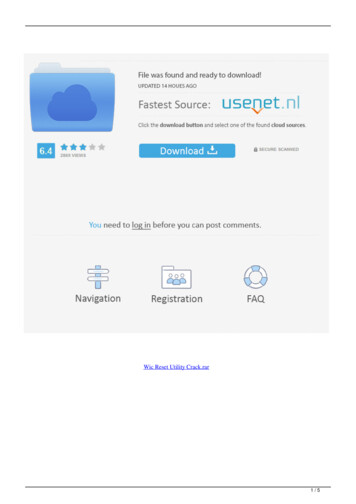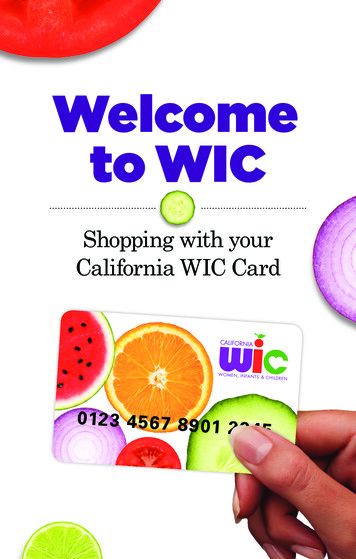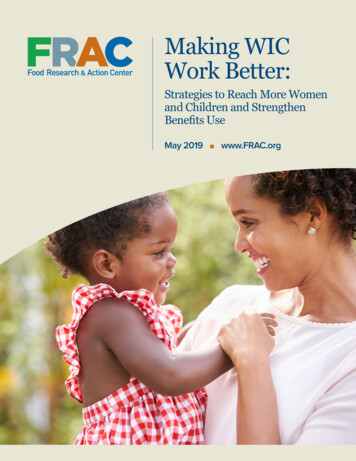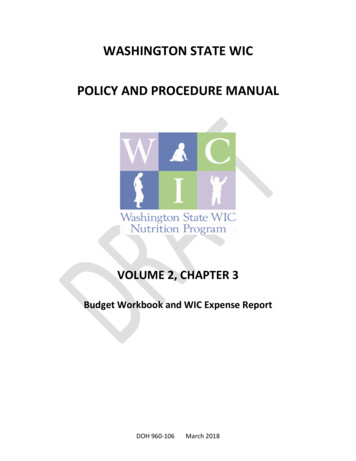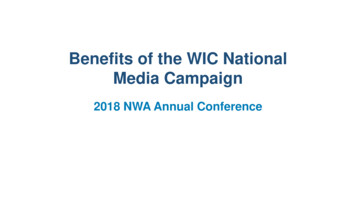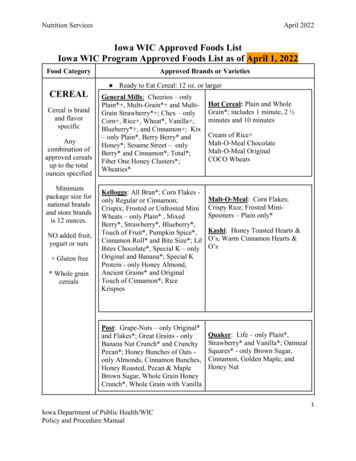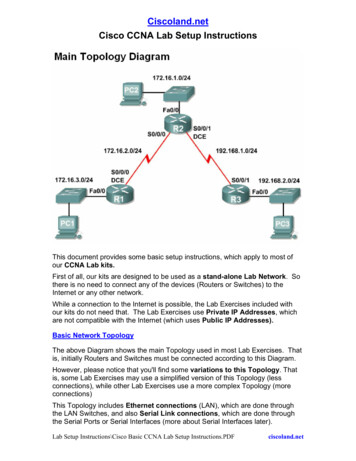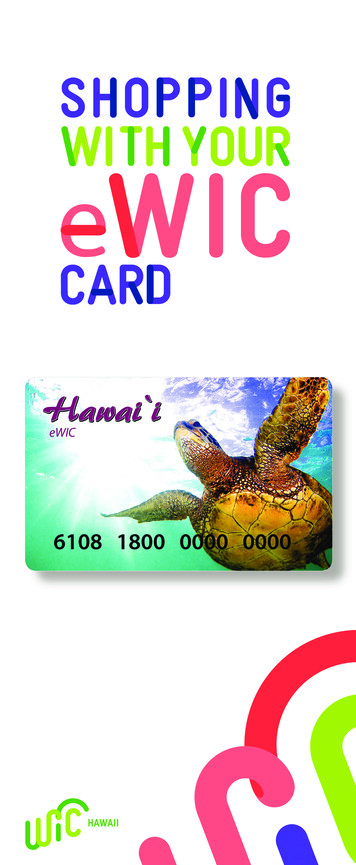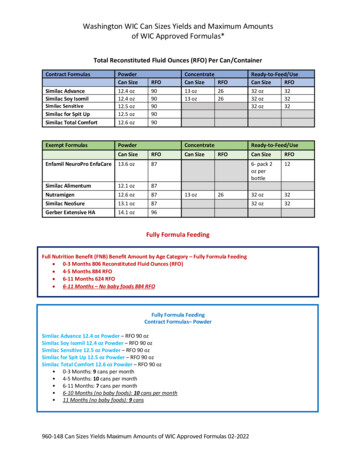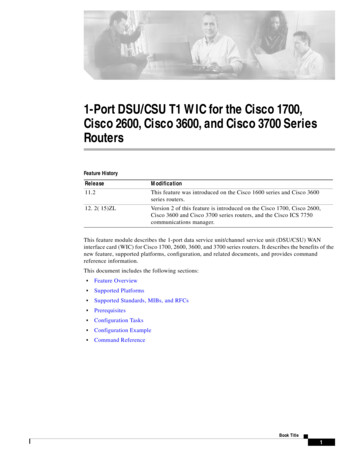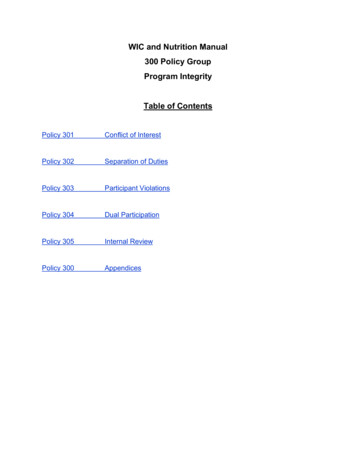
Transcription
UPDATED MAY 2022WIC Certification Overview ModuleWIC Appointments- Section 1ObjectivesAfter this section, you will be able to Understand the layout and purpose of the Minnesota Operations Manual.List the 4 main types of WIC appointments/visits that WIC staff perform in clinicDescribe what happens during each appointment typeState the certification period for each participant categoryObserve the 4 main types of appointmentsOverviewThere are four basic appointment/visit types staff perform in the WIC clinic. Understanding thesewill help you better understand day-to-day WIC operations. It will also help you understand thefrequency in which a WIC participant is expected to come to WIC and the purpose for each ofthese visits. The activities that occur within these appointments are outlined by USDAregulations.Minnesota Operations Manual (MOM)Federal regulations outline “rules” for the WIC program. The policies and procedures MinnesotaWIC has developed to meet these regulations are found in the Minnesota Operations Manual(MOM). MOM is on the MDH WIC website under the section Local Agency /Finance and ProgramManagement/ MN Operations Manual (MOM).MOM is arranged into chapters, and under each chapter are various sections. When a policy isreferred to, it’s usually listed as numbers, i.e., MOM Section 5.2.1 refers to Chapter 5, Section 2,and Part 1 of MOM. Charts, forms, or other references related to a Section of MOM are found inthe Exhibit section under each Chapter to which it pertains.MOM is referenced throughout these training modules. As you go through your training, you areencouraged to become familiar with the information contained in MOM. Refer to MOM if youneed more detail than is contained in the overview modules or to research a question.
WIC CERTIFICATION OVERVIEW MODULECertification AppointmentsA certification appointment is the very first WIC appointment for a WIC applicant. Thisappointment is often referred to as a “Cert” and is the appointment during which eligibility forthe WIC Program is determined.Applicant Prescreening:Prescreening occurs before the certification process actually begins. Prescreening is used todetermine if a person interested in WIC is likely eligible to receive the services, based on federalprogram guidelines. Potential WIC participants will usually call the WIC office and a WIC staffperson will prescreen them over the phone for potential eligibility.Prescreening Procedure:To perform the prescreening, a staff person will create a “record” in HuBERT and ask thefollowing information:Does the applicant: Live in Minnesota? Is the category served by WIC?oPregnant womanoPostpartum woman within 6 months of deliveryoBreastfeeding woman within 12 months after deliveryoInfant under 12 monthsoChild age 1 through his/her 5th birthday Are they eligible or participating in an adjunct program? If not, does income appear to fall within WIC Income Guidelines?If the prescreen reveals that the person is likely eligible for WIC, then a certificationappointment will be scheduled. A prescreening does not guarantee eligibility. Eligibility isdetermined at the certification appointment.HINT: An appointment cannot be scheduled in HuBERT until after a “record” is created andprescreening is performed. (Refer to HuBERT Training – Participant List for more information)Processing Standards:There are federal regulations that specify how quickly a new WIC applicant must be seen in theWIC clinic. Pregnant women, infants less than six months of age and migrant families must beoffered an appointment within 10 calendar days. Other applicants must be offered an appointment within 20 calendar days.(MOM Section 3.2 Processing Standards-Timeframes for Scheduling Certification Appointments)2
WIC CERTIFICATION OVERVIEW MODULEThe date of initial contact and the date of the first appointment offered must be recordedcorrectly in HuBERT in order to have documentation that this regulation is being followed. (Referto HuBERT Training Modules: Initial Contacts for Meeting Processing Standards)Certification ProcedureAt the certification appointment, staff will open the record that was created during theprescreening in HuBERT and click on the Certification Guided Script (CGS) to start theappointment. All applicants must be physically present at certification appointments. (See MOMSection 5.2.5 for exceptions) Detailed information about each part of the certification procedurewill be covered later. (MOM Section 5.2 Certification Procedures)1. View documents to verifya. Identityb. Residencyc. Income (or adjunctive eligibility)2. Collect health informationa. Anthropometric data (height and weight)b. Hemoglobin (through a finger stick)c. Health History--Past and current medical conditions to assess for health risks.3. Complete the Nutrition Assessment. Together with the health information, nutritionand eating behaviors are considered to assess for nutrition risks.4. Assign risk codes based on the health information and the Nutrition Assessment. Atleast one nutrition risk code must be identified to be eligible for WIC.5. Provide Nutrition Education based on the health and nutrition assessment and theparticipant’s concerns, interests and priorities. The CPA and participant collaborativelydecide on a nutrition or health area to discuss. The CPA encourages the participant todetermine a specific, attainable nutrition or health goal that’s right for her to makeprogress towards improving health habits. Information and education on the harmfuleffects of drugs and alcohol and referral resources must be provided at the first WIC visitfor a WIC family. ( MOM Section 6.4)6. Make referrals as appropriate, to other community and health programs. The CPA mayoffer referrals to other community and health programs as needed. You will learn moreabout referrals available in your area from your agency. Referrals are documented inHuBERT to allow follow-up on whether the participant was able to connect with theorganization etc. It also allows your agency to track referral information.7. Assign the Food Package based on the participant’s category and tailor it to their individualnutrition need. For example, if a participant has a food allergy, that food item must beremoved from the package. If a participant states that they do not want a food, it can alsobe removed. Food Benefit Issuance. One, two or three months of food benefits may be issued.The number of food benefits issued should be based on the need for follow up.3
WIC CERTIFICATION OVERVIEW MODULEThree months of benefits is appropriate for many participants. High riskparticipants may need to be seen in one or two months, so issuance shouldcorrespond. It will be one month if proof of identity, residency, and/or incomewas not provided at the certification. Benefit Education. Explain the food benefits and how to shop for WIC foods if thefamily is new to WIC. See MOM Section 7.2 . If a family has not participated inWIC for a while, remember to update them on any food package changes thatmay have occurred. Routinely check in at each WIC visit to ask how the shoppingexperience has been and whether the family was able to purchase the WIC foodsthat they wanted. Answer any other questions a family may have about theirbenefits or shopping for WIC foods.8. Give the WIC Card to the participant. Write the participant’s Household ID on thebackside. This card will be used at the store and should be brought to their subsequentWIC visits.9. Obtain signatures. The participant must read the Rights and Responsibilities Form (or readthe R&R to them) and sign the signature pad, acknowledging acceptance. The staff personwho determined eligibility must also sign the signature pad verifying that they determinedthis person to be eligible for WIC.10. Provide materials. New WIC participants will need:a. Welcome to WIC Brochureb. WIC Shopping Guidec. Information on how to find WIC authorized Vendors (WIC Grocery Stores)11. Schedule the next WIC appointment/visit (usually an Additional Nutrition Education Visit).If the next visit will be a walk-in visit, be sure to indicate the week in which the participantshould return to clinic or contact their local WIC agency by phone.Certification PeriodsWhen a person is determined eligible for WIC, he/she is certified for a specific period of time(generally 6 months – 1 year). This is referred to as the certification period. At the end of thecertification period, a participant’s eligibility must be re-evaluated and this is called a“recertification”. Pregnant woman – From certification appointment to the last day of the month in whichthe infant is 6 weeks old or the pregnancy ends; may be recertified as a breastfeeding ornon-breastfeeding woman. Breastfeeding woman – From certification appointment following delivery until the lastday of the month in which the infant turns one year old or the woman stopsbreastfeeding. Non-breastfeeding, postpartum woman – From certification appointment followingdelivery until the last day of the 6th month after the baby was born. Infants under 6 months – From their first certification appointment until the last day ofthe month in which the infant turns 1 year old.4
WIC CERTIFICATION OVERVIEW MODULE Infants 6 months – Certified for 6 months; then may be recertified for one year. Children – Certified for one year. Eligibility ends on the last day of the month in whichthe child turns 5 years old.Recertification AppointmentsWhen the participant’s initial certification period ends, s/he must be recertified to continuereceiving WIC services. This is called a recertification appointment, referred to as a “recert”. Recertifications follow almost the same procedures as certifications. Some participant information is already stored in the WIC Information System; it must bereviewed and updated as necessary. Review notes from the previous appointment when doing a recertification appointmentin order to follow up on health and nutrition concerns and goals, and to providecontinuity of care. The participant must provide current documentation of identity, residency and income. During the recert appointment assess the participant’s health and nutrition status,provide counseling and nutrition education appropriate to the needs and interests of theparticipant. Assign the appropriate food package.Recertification Scheduling Considerations The goal is for the recertification appointment to occur as the current certificationexpires so that the participant does not miss out on any food benefits. Recertification appointments are ideally scheduled in the calendar month that theprevious certification ends. The exception to this rule is infants that are turning 1 year ofage. When an infant turns 1, their category in WIC changes from an infant to a child andtheir food package changes.ooIf their food benefit “first day to use" (FDTU) is after their date of birth(DOB), then schedule the recert in the month their certification ends.If their FDTU is before the DOB, then schedule their recertification for thefollowing month.Midcertification AppointmentParticipants certified for a period greater than 6 months (infants, breastfeeding women andchildren) require a midcertification nutrition assessment, referred to as a “midcert”. Thisappointment focuses on nutrition assessment and education. The administrative components ofcertification are not required, including: Proof of income, Proof of address, Proof of ID, Rights andResponsibilities. This allows more time to focus on nutrition education and the participant’snutrition goals.Midcertification Scheduling ConsiderationsIn general, midcertifications should occur at:5
WIC CERTIFICATION OVERVIEW MODULE Infants – at 9 months of age Children – 6th month of certification (5-7 month time frame) Breastfeeding women – 6th month of certification OR at the same time as infant’s midcertification appointmentMidcertification ProcedureOpen the Midcertification Assessment Guided Script and perform the following: Demographics — only check to see if there are changes in address or phone. Height/Weight/Blood – obtain Ht/Wt measurements and record. Bloodwork may beneeded. Refer to MOM Section 5.3.2 for bloodwork schedule. Health/Nutrition Assessment – review and update as necessary to identify majorchanges in health status and/or dietary and physical activity. Include: o Review of last nutrition/health assessment at certificationo New concerns raised by the participanto New medical diagnoseso Changes in eating pattern/food intake/food packageo Changes in physical activityImmunization screening – for infants and children under 2 years of age. Follow up asnecessary, based on screening and/or referrals given at certification. Nutrition Counseling and Education -- based on participant interest and should includeany follow up on concerns and goals from the last appointment. Nutrition Educationshould be where the majority of time is spent for midcertification appointments. Referrals/Other Programs—if needed. Food Package -- make any changes necessary. Check in with participant to see if theyhad any questions/challenges when utilizing their benefits.Additional Nutrition Education ContactNutrition education must be offered to WIC participants at least quarterly. To meet thisrequirement, WIC participants receive nutrition education at Initial certification Midcertification Recertification Two additional times within a one year certification period, usually midway between thecert/recert and midcert appointments.This appointment may be referred to by different names from agency to agency, such as afollow-up visit or a check-in visit either in person or by a phone/video contact.Generally, Additional Nutrition Education occurs any time the participant calls or returns tothe clinic to renew their food benefits. For participants who are not high risk, this is usually 3months after their Cert/MidCert/Recert appointment. Clinics may or may not schedule an6
WIC CERTIFICATION OVERVIEW MODULEappointment for Additional Nutrition Education but instead, complete these visits when aparticipant calls or walks in to the WIC clinic. Whether an appointment is scheduled or not,the participant will meet with a CPA for additional nutrition education. Various options areavailable for the additional education requirement. See MOM Section 6.7 AdditionalEducation.Additional Nutrition Education ProcedureAt this visit, typically, the CPA will review notes from the participant’s previous visit and thenwill:1. Discuss with the participant any important changes. If pertinent, update healthstatus/reweigh/measure/retest blood.2. Provide Participant Centered nutrition education. Discuss any progress on goals/notesfrom last visit and address participant concerns and interests. Offer anticipatory guidanceif no other concerns or interests emerge (especially applicable during the infant/toddlerperiod).3. Consider the frequency of food benefit issuance based on health and nutrition factors.Note: Additional Nutrition Education Visits are not just for “benefit renewal”. If the term “benefitrenewal” is used, it could imply the only thing the participant will do is renew food benefits. If thisis the participant’s expectation, and they are then asked to stay a few minutes to visit with a CPA,this may lead to resistance. Frame nutrition education as a WIC benefit. WIC sets aside time forthem to discuss their personal nutrition progress and concerns with a staff member at eachcontact.High Risk ParticipantsParticipants with more complex or serious health/nutrition concerns are considered “high risk”.They require more specialized care, often provided by CPAs with more advanced nutritiontraining. To ensure quality, comprehensive care for their condition, the CPA will develop anIndividual Nutrition Care Plan (INCP) to more aggressively address and resolve the high riskcondition. CPAs providing high risk care will review the High Risk Modules as part of their NewStaff Training.Breastfeeding SupportBreastfeeding is the healthiest feeding choice for both mothers and their infants.Breastfeeding education is provided to all prenatal woman. It may be necessary to onlyprovide one or two months of food benefits if mom has lots of breastfeedingquestions/concerns or lacks confidence in her ability to breastfeed, or if she enrolled late inpregnancy, in order to better support and prepare her for breastfeeding.Some other types of breastfeeding support offered at WIC clinics include: Breastfeeding classes Breast pump information7
WIC CERTIFICATION OVERVIEW MODULE Lactation specialists to help with breastfeeding challenges Breastfeeding peer counselorsSupport continues after the baby is born for the mother/infant dyad. The early postpartumperiod is a critical time to address breastfeeding questions and concerns. The CPA, working withthe new mother, should determine how soon and how often the breastfeeding mother andbaby need to be seen. Factors to consider: Infant’s age Mother’s experience Other support systems available to the mother How well breastfeeding is goingIt may be best to schedule breastfed infants to return in a month for additional support and torenew their next month’s food benefits. Once the CPA and mother agree that breastfeeding isgoing well and the mother’s questions and concerns are addressed, the family may be switchedto tri-monthly food benefit issuance.TransfersA current WIC participant can transfer his/her certification to another county or state if s/hemoves or requests to receive services in a different in-state agency. A participant transferringfrom another state should arrive with a Verification of Certification (VOC) form or card. WICstaff can also contact the state WIC program from which the participant is transferring to verifycurrent eligibility. Refer to the USDA VOC Contacts Map to find contact information for otherstates and tribal programs.Print and sign a VOC for any participant who will be moving out of the state, as well as a copy ofthe Medical Documentation form for those receiving Food Package 3. Explain how to transferservices to another state.A VOC is not required for a participant transferring within Minnesota since WIC staff can look upthe participant in the WIC Information System. If a transferring participant’s certification periodhas not ended, s/he is eligible to continue receiving WIC services uninterrupted at your clinic -staff do not need to reassess income eligibility, but the participant will need to show currentdocumentation of residency as well as documentation of identity.8
WIC CERTIFICATION OVERVIEW MODULEPractice Activity - A1. Locate the Minnesota Operations Manual on the MN WIC Website. (Hint: it’s under theLocal Agency tab) Familiarize yourself with MOM Chapter 5: Certification, noting whatinformation is contained within this chapter.2. Review the form, Your Rights and Responsibilities in WIC. Ask your preceptor todemonstrate the procedure for signing the signature pad. Also ask for a demonstrationof how to scan a signed paper copy into the Information System.3. Ask your WIC Coordinator what types of breastfeeding support are offered at your clinic.4. To what community services or programs does your clinic commonly referparticipants? Review any referral information that your clinic may use.5. Observe a variety of appointments and procedures from start to finish.Note the various steps in the certification process during your observations.Your preceptor can help arrange your observations. Applicant Prescreening (If possible, observe staff screen applicants over the phone.) Participant transfer in or out of the agency (if possible) Certification – Pregnant Woman Certification – Infant/BF Mom Certification – Child Recertification – Child Mid-certification—9 month Infant or Child Additional Education Contact (Nutrition Education)9
WIC CERTIFICATION OVERVIEW MODULESkills Check - #11. What are the 4 main types of appointments that WIC participants are scheduled for whenenrolled in WIC?2. What is the purpose of prescreening?3. What is the purpose of the certification and recertification appointments?4. How do cert/recert appointments differ from mid-certification appointments?5. How often do participants receive nutrition education?10
WIC CERTIFICATION OVERVIEW MODULEIdentity, Residency & Income Documentation- Section 2ObjectivesAfter completing this section, you will be able to: Describe the documentation the participant is required to bring to the certificationappointment.OverviewFor each WIC certification and recertification appointment, the applicant is asked to providedocumentation of identity, residency and income. Staff need to review this information to assessthe participant’s current eligibility to receive WIC services. Staff are also responsible fordocumenting the information on identity, residency and income in the participant’s electronicrecord. WIC does not require proof of US citizenship. WIC does not require proof of pregnancy, unless staff have reason to believe theapplicant is not being truthful about the pregnancy.IdentityEach time a person is certified for WIC, s/he must show documentation of identity (ID). Thisrequirement is established by the federal government to help prevent fraud.WIC staff must ask to see documentation of identity at the first certification, recertificationappointments, and when participants are picking up food benefits at the clinic. Staff may wantto routinely ask each participant, “Did you bring something with your name and current addresson it, such as a driver’s license or paystub?”Some examples of acceptable forms for documentation of identity include: birth certificate,baptismal certificate, crib card, driver’s license, passport, photo ID issued by an employer orschool, or a Health Benefits card. See MOM Section 5.2.3 Identity for a full listing of possible ID’s.NOTE: “Known to staff” and “the WIC Card” are acceptable documentation at recertifications andissuance of food benefits.ResidencyEach time a person is certified/recertified for WIC, s/he must show documentation of residency.This requirement is established by the federal government to help prevent people from receivingWIC benefits at more than one WIC clinic.Documentation of residency is used to determine if the applicant actually lives in Minnesota.11
WIC CERTIFICATION OVERVIEW MODULEWIC staff must ask to see a document that shows the participant’s name and current address.While most applicants/participants will request services from the WIC provider in their county ofresidence, some may prefer to receive services from a WIC provider in another service area (e.g.,the county in which they work). A listing of local agencies is available on the WIC website at WICAgency Directory.Examples of acceptable forms of documentation of residency include: a bill, driver’s license,lease agreement or rent receipt, mail addressed to applicant, or pay stub. For a completelisting, refer to MOM Section 5.2.2 ResidencyNOTE: Residency refers to the place that the person normally sleeps at night.IncomeEach time a person is certified for WIC, s/he must show documentation of income. This willdetermine if household income falls within the WIC Income Guidelines.Detailed information on how to determine income eligibility is found in MOM Section 5.2.4:Income.Missing DocumentationIf a person does not bring documentation of identity, residency or income to their WICappointment, s/he can be certified on that day, provided with one month of food benefits, andasked to bring the documentation within 30 days. If s/he does not bring the missingdocumentation within 30 days, s/he will no longer be eligible to receive WIC benefits until thisdocumentation is provided.If a person cannot provide documentation of identity, residency or income due to specialcircumstances (such as theft, disaster, homelessness or migrant status), s/he can fill out and signthe Certification Notice form (generated in HuBERT) indicating that s/he is unable to provide thisinformation and why. This information is scanned and saved in the participant record.12
WIC CERTIFICATION OVERVIEW MODULESkill Check - #21. Review MOM Section 5.2 Certification2. What are three acceptable forms of documentation of residency?3. List three acceptable forms of ID for children.4. List three acceptable forms of ID for women.5. Practice what you would tell a participant about what documentation s/he needs to bringto the certification appointment. It may be helpful to practice aloud with a co-worker.13
WIC CERTIFICATION OVERVIEW MODULEIncome Eligibility- Section 3Objectives:After completing this section you will be able to: Correctly screen for income eligibility Correctly follow separation of duties proceduresOverview:Each time a person is certified for WIC, income eligibility must be determined. There are two waysto determine income eligibility: adjunctive eligibility and by calculating household income.Income Eligibility:Adjunctive EligibilityAdjunctive eligibility is a term used to describe “automatic” income eligibility for WIC, based oncurrent income eligibility for another program.Household Adjunctive Eligibility:If anyone in the household has been determined eligible for one of the following programs, othermembers of the household are income-eligible for WIC. The applicant must providedocumentation of current eligibility in the adjunctive program. Staff must assist as appropriate todetermine current eligibility. Medical Assistance Minnesota Care Minnesota Family Investment Program (MFIP) Food Stamps/Supplemental Nutrition Assistance Program (SNAP) Free or Reduced Price Meal Eligibility for School Lunch Head Start Fuel AssistanceApplicant Only Adjunctive Eligibility:For some programs, adjunctive eligibility applies only to the applicant currently eligibleto receive benefits, not the whole family. Other family members are not adjunctivelyeligible. These programs are: Supplemental Security Income (SSI) Tax Equity and Fiscal Responsibility Act (TEFRA)See MOM Section 5.2.4 Income for more details on Adjunctive Eligibility.14
WIC CERTIFICATION OVERVIEW MODULETraditional Income Determination:If the participant or household is not income-eligible based on adjunctive eligibility, staff mustcalculate total household income. Staff must document all sources of income for thehousehold. The household size and total income are compared to the WIC Income Guidelines todetermine if the household is eligible for WIC.What is a Household?For the purposes of WIC, a household is defined as:A person or group of people, related or not, who usually (though not necessarily) live togetherand who share income and the consumption of goods and services.Specific Situations for Determining Household size: A pregnant woman should be counted as two or more, taking into account the numberof unborn fetus(es). Active military duty: If the household includes a parent or stepparent who is on activemilitary duty, the absent member may be considered a member of the household. If thechild is living with others such as grandparents because the parent(s) is on active militaryduty, the child(ren) may be considered a separate household if this is more favorable totheir eligibility. Split or joint custody: When the custody of the child is split, the child shall be considereda member of the household in which he or she lives the majority of the time. If theparents share custody 50/50, the child can only qualify for WIC in one parent’shousehold. Parents can be encouraged to share the food or have the other parent as aproxy for the child. If custody papers are available, staff should consider custodyarrangements when issuing food benefits. If an adult in the household is making child support payments for a child not living in thishousehold and who is not receiving WIC food benefits in another household, this childmay be counted as a member of the household. Child support payments do not reducefamily income. A foster child, who is living with a family but remains the legal responsibility of a socialservice or other agency, should be considered a family of one. These children are usuallyeligible for Medicaid (MA). If siblings enter the same foster care home, the number ofsiblings can be considered the household size and one household ID number assigned tothem.Household Size Examples: Sophie lives alone in an apartment. She is pregnant with twins. She has Medicaid.Sophie’s household size would be three (3). Josefina lives with her boyfriend. They have a 2 month-old baby who lives with them.Josefina receives MFIP payments, her boyfriend works part-time, and they shareexpenses. Josefina’s household size would be counted as three (3).15
WIC CERTIFICATION OVERVIEW MODULE Candy has a 3 year-old son and lives with a roommate. She works and so does herroommate. She and her roommate split the rent and utilities evenly, each paying half.Candy and her son buy their food separately and eat separately from her roommate.Candy’s household size would be two (2).Income CalculationFor WIC purposes, income is calculated by adding the income of all household members.Generally, the most common documentation of income used for calculating income includes: Gross income from current pay stubs (this is the amount BEFORE deductions) Unemployment award letter W-2 forms or income tax return (for self-employed individuals) Foster child payment statement Signed letter from employer stating gross earnings Benefits or earnings statements Letter of alimony or child support paymentsRefer to MOM Section 5.2.4 Income for additional sources of income.Enter all relevant sources of income for each household member into the InformationSystem. WIC staff must select the correct payment frequency and rate for each sourceof income. The Information System will assist in calculating household income.Income Determination Examples: Jordan is paid 300 once a week. 300 is entered with a “wee
Nutrition Assessment. Together with the health information, nutrition and eating behaviors are considered to assess for nutrition risks. 4. Assign. risk codes. based on the health information and the Nutrition Assessment. At least one nutrition risk code must be identified to be eligible for WIC. 5. Provide. Nutrition Education
